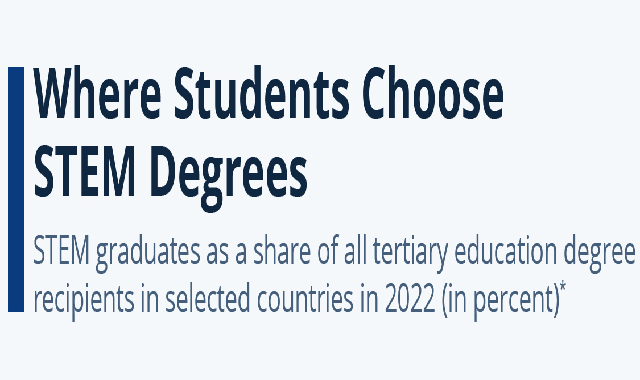Graduates in STEM – acronym for fields of science, technology, engineering and mathematics are in demand globally but often are in short supply. Many countries have tried to encourage their youth to enroll in STEM to facilitate important growth industries like medtech, digital services, mobility or computer sciences. However, countries have had varying success in the matter.
The report collecting numbers by the UNESCO Institute for Statistics, shows that tertiary students in Malaysia and Tunisia are among the most likely to graduate in a STEM field, with between 43.5 and almost 40 percent of students there getting a respective degree, out of all countries where recent data was accessible. India has a relatively high share of 34 percent of students picking STEM, and is producing the most graduates in total in the field due to its population of around 1.4 billion people, considered the largest in the world.
UNESCO did not issue any data for China. In 2016, the World
Economic Forum said that China actually produced 4.7 million STEM graduates a
year, which would actually beat India’s number. Yet, according to the National
Science Foundation, China classifies engineering and science fields quite largely,
leading to a lack of comparability in the data. This U.S. government agency calculated
1.6 million Chinese science and engineering graduates in 2014, and that number
would be small than Indian graduates.
Other countries that have a strong showing of STEM graduates
are the United Arab Emirates, Germany, Belarus and South Korea – all producing
more than 30 percent STEM graduates each year. In general, countries that have
managed to produce a higher share of STEM graduates than elsewhere are more
likely to be found in the Arab world, in Eastern Europe and also in East Asia.
After Tunisia, the share of STEM degree recipients is also upwards of 29% in
Algeria, Mauretania and Morocco, all due to the popularity of computer
engineering in the region. The place that has recently been pushing to modernize
its economies - Arab Gulf, is generating an above-average number of STEM grads
in some places, specifically in the UAE and Oman.
With the exception of Germany, Western Europe is not a STEM hot
house, however. Only 26 percent of UK graduates come from STEM courses, as do
25 percent in France and 23 percent in Spain. The number of graduates is even little
in the Americas, with shares of 19.6 percent and 17.5 percent in the U.S. and
Brazil, respectively.
Infographic by: statista


